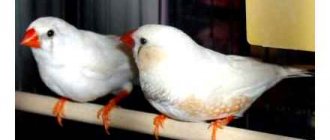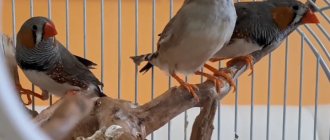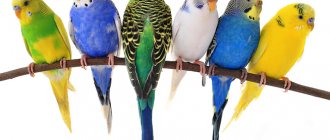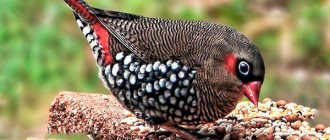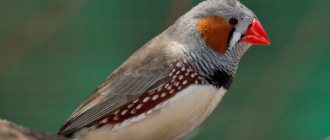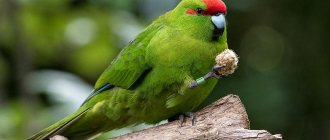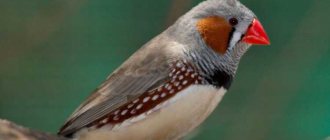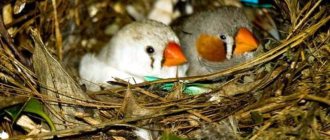The Japanese finch is a small ornamental bird that began living in the home four centuries ago. The Japanese finch is the result of the work of breeders; it belongs to the family of finch weavers and is characterized by friendliness and activity. The bird is gregarious and does not tolerate loneliness: they usually have a pair or several finches at once. The bird grows up to 13 cm in length, its wingspan reaches about 20 cm, and its weight ranges from 5 to 12 grams. Life expectancy ranges from 8 to 10 years.
The Japanese finch is not capable of reproducing human speech and other sounds, but it has vocal talent. The bird reproduces well: it can give birth 2-3 times per year, the number of chicks is from 4 to 8. The color of the birds' feathers is dim and is in a creamy-brown range. As a result of selection, many other, brighter shades of plumage were developed: red, green, blue, gray, yellow, etc.
Description, appearance
Japanese finches are bred artificially. They are the result of crossing wild Chinese finches and bronze manakins.
The bird has a thick, curved beak and variegated feathers painted in contrasting colors. Females and chicks have less bright plumage than males. The Japanese sparrow finch is small in size.
Birds have a number of features:
- upper body brown;
- the lower part is gray or white;
- some individuals have monochrome plumage (red, white, yellow, pearl finch);
- shades can be combined;
- the color is often asymmetrical.
The beak of birds of this species is blue-black above and light below.
The Japanese finch loves to be in the neighborhood with other birds, has a calm character, and does not like fights. He can easily live with his relatives in the same cage. It is worth noting that white individuals are slightly weaker than others due to health reasons. They have slow growth and lower fertility. They also often have physical disabilities.
In the last century, the crested Japanese finch (as in the photo) was bred. They differ from each other in the type of crest. It can be bunch-shaped, lush-thick, double. Curly Finches have also appeared. Their main difference is the curled feathers on the chest, back and shoulders.
How long do finches live? With proper care, approximately 10-12 years.
Japanese finch singing
Even though they are songbirds, they do not sing very well. The singing of the Japanese finch is more like whistling or chirping. Although the sounds are very melodic:
How to choose a bird
To become the owner of a healthy and viable finch bird, you need to contact experienced breeders or specialized stores. When choosing, it is recommended to pay attention to the appearance and behavior of the proposed individuals. A healthy finch bird has:
- booming voice;
- springy, clear movements;
- light, slightly pinkish skin;
- moderately well-fed physique;
- dense plumage without signs of ticks and other parasites.
Amadins are small exotic birds with a lively temperament and variegated colors. Vocal songbirds are undemanding in everyday life and, with minimal care, will delight their owners with their presence for a long time.
Keeping finches at home
As stated above, finches do not like loneliness, so they get along well with both their relatives and other small birds. If they don't have company, they get bored, don't sing, get sick and may even die.
Attention! Finches do not really like human society. They also do not like to be picked up or allowed indoors.
Arrangement of the cage
The bird doesn't care what size the cage is. It can be placed either in a small “house” or in a spacious enclosure. The only requirement is the presence of a secluded place for proper rest. You need to put a nest or nest box in the cage for them. They will provide an opportunity to hide from prying eyes.
The minimum cell dimensions look like this: 30x30x50 (width, length, height, respectively). In appearance, the cell should resemble a parallelepiped with a rounded or horizontal top. This shape gives the birds room to flutter around the perches. Under no circumstances should you buy round cages. Finches experience discomfort in them. Moreover, they lose orientation in space.
Bird housing should have the following accessories:
- 2 types of feeders (for dry and succulent food);
- one or more drinkers (preferably automatic);
- wooden perches placed at different levels.
It is also worth putting a container for bathing. It is placed at the bottom of the cage or suspended. For Japanese finches, swimming is an exciting pastime.
At the bottom you need to make a bedding of sand, sawdust, shavings or paper.
Diet
Properly selected food is the key to the health of feathered pets. Feed mixtures can be purchased at a pet store or prepared at home.
The main part of the diet of Japanese finches is grain mixtures. The mash includes millet, canary seed, weed seeds, chumise, and mogara. They should be fresh, without a musty smell.
An additional part of the menu is food of animal origin. We are talking about maggots, mealworms, fruit flies, insect larvae, minced meat, cottage cheese and egg yolks.
Soft food should be introduced into the diet gradually. It should be prepared every day. The simplest recipe: boiled egg, grated carrots, cottage cheese, white bread.
Sunflower, oil seeds and rapeseed can be added to grain mixtures.
During nesting of finches, it is recommended to add crackers, carrots, cottage cheese, yolk, and dried insects to the birds’ diet.
Housing
The cage for finches may not be too large, but with special adjustments: it should be larger in height than in length and width. The fact is that the bird does not feel the desire to often flutter around the room, some owners do not let them fly, and the “Japanese” do not suffer from the lack of free flight.
But they love to flutter, jump from perch to perch, and climb up and down the rods.
Perches are needed of different lengths and thicknesses, not necessarily even; you don’t need to clean the branches from the bark.
A rectangular option along the lower perimeter is allowed, but in no case round! In round cages, these birds will lose orientation, feel uncomfortable, start fighting, and can damage their plumage on the bars.
Breeding at home
Raising Japanese finches at home is not that difficult. However, you need to strictly adhere to some rules.
The breeding cycle lasts 55 days and consists of several stages:
- preparatory;
- laying eggs, incubation;
- cultivation;
- chick separation.
The preparatory stage has a lot of features and nuances:
- First you need to check if your pets are healthy.
- The female should not be younger than 9 months.
- It is better to breed finches in a separate room.
- It is recommended to artificially increase daylight hours to 16 hours.
- Animal proteins, special mixtures with calcium, phosphorus, and vitamins should be added to the birds’ diet.
- Separately, it is worth preparing a nesting house.
- Provide the finch with the material necessary to equip the nest. This is hay or coconut fiber.
difference between female and male finches photo
Amadin is a very common breed of bird that was bred artificially. Unfortunately, information about the ancestors of this bird is so contradictory that they have not yet been established. Among the possible progenitors are the Chinese sharp-tailed finches. Unlike the ancient snow-white Japanese finches, today the color variety is impressive. This unpretentious bird, which can be bred independently, has been in constant demand all over the world for many years. After all, she doesn’t need to fly often; she patiently gets along with her neighbors.
Diseases and molting of the Japanese finch
Sometimes it may indicate that the bird is sick. She loses her appetite, becomes lethargic and inactive, and loses her feathers. Most often this is not due to disease, but to molting. The first occurs between 1.5 and 3 months of age. It lasts quite a long time, sometimes several weeks.
During the molting period, food with a high content of vitamins and minerals and sprouted grains should be added to the amadine’s diet. As soon as the molting is over, the birds will again become cheerful and active.
Japanese finches are “comfortable” pets. They do not require special conditions of detention. Moreover, they practically do not need human attention. Birds feel good in the company of their relatives. The main thing is to provide them with everything they need for a full life.
How long to keep at home
These birds are collective creatures, and if a Japanese finch is acquired alone and lives alone at home, it will not die, but the bird will sing less and jump on perches.
It will be much more fun for them and for the owners if several Japanese are kept, and you can keep only males or only females if there are no plans for breeding.
Same-sex finches will not conflict if they live together.
Even with other small, non-conflict birds, Japanese finches will be friends; they rarely get into quarrels and fights.
Taming
The success of taming depends on daily practice. It will be much easier to work with barely fledged chicks who are just discovering the world. Adult birds have a mature character, they are more difficult to make contact and get used to new things.
An important rule when taming is that you should only train one bird at a time. To begin taming the finch, you should place the “student” in a separate cage. Let him get comfortable there and start the lesson.
The first thing you can try is to make the bird jump onto your hand. To do this, carefully put your hand into the bird’s cage so that it huddles in a corner, and the only possible movement option for it is to jump on your hand.
When the bird gets comfortable and gets used to being on your hand, you can carefully try to take it out of the cage. An important point here is to trim the wings so that the bird cannot fly out the window or harm itself in any way.
If you get the bird out of its cage, put it on your shoulder and go about your daily quiet activities, watching a movie, reading a book. This is necessary so that the feathered friend gets used to the environment and feels more confident.
The tame finch should have some kind of place in the room: a play corner or stand, a chair, or maybe several perches where the bird can rest from a walk.
Reproduction
Breeding is a serious step and requires a responsible approach to the matter. To produce good offspring, both individuals must be healthy.
Amadins should not mate during molting. The best time for reproduction will be spring-summer, at this time there are plenty of natural vitamins, and the weather outside is warm.
Conditions
It is necessary to create the proper conditions for reproduction. Dry grass, hay, and moss should be placed in a closed nesting house. Some material should simply be placed in the cage to encourage the male to build a nest.
During nesting, the cage should be carefully cleaned to prevent the appearance of parasites.
Caring for chicks
After the chicks are born, the parents feed them and warm them with warmth. When watching finches, the main thing to note is the moment when the parents begin to feed the chicks with food, it is then that the diet needs to be supplemented with protein food.
When the chicks are seven to nine days old, they will begin to fledge. To help them at this stage, add mineral supplements, weed seeds and other plants to their parents' food.
You can tell if the chicks are full by their sounds. If their parents feed them well, the chicks remain silent for most of the time.
There are situations when, for some reason, birds refuse to fulfill their parental responsibilities. The reason for this could be many different factors. In such cases, you will have to feed and warm the babies yourself.
Cage care
Of course, birds should not be allowed to drown in dirt and live in unsanitary conditions! Japanese finches are in good health and rarely get sick.
This is probably because for many centuries they often had to huddle together in small cages. But daily cleaning and a thorough “wet” cleaning every month will be necessary.
We do wet cleaning as standard: after we have removed visible dirt, we wash it first with cold, then with hot water, then with a weak solution of laundry soap we go through the corners and joints of the rods. Rinse again with clean warm water (to wash away any remaining soap) and dry.
These birds are not shy and will allow themselves to be picked up, but this must be done carefully and gently.
You need to feed the Japanese finch with settled water; boiled water is “empty.” Be sure to change the water and wash the drinking bowl daily.
What to feed
Not everyone’s food is suitable for the “Japanese”! Under no circumstances do we provide food for parrots or simply for small and medium-sized birds; we need a mixture for exotic birds from a well-known manufacturer of bird food.
We carefully read the composition of the purchased food, it should be something like this: for 10 parts of millet (yellow) - 1 part rapeseed, 1 part or a little more oatmeal, 3 parts canary seed, preferably 1 part each of hemp and chumise seeds, also part of meadow wild grasses (for example, plantain, clover or dandelion). A teaspoon of dry mixture per bird is enough.
Chopped green (fresh, not limp) lettuce leaves, dandelion and plantain leaves - this is what Japanese finches love and this is also extremely useful for them to give.
We give pieces of fruit without restrictions, but remove uneaten remains in a timely manner. Birds will also eat a hard-boiled egg with pleasure, and sprouted grains are both healthy and loved. But these supplements must be given without fanaticism.
